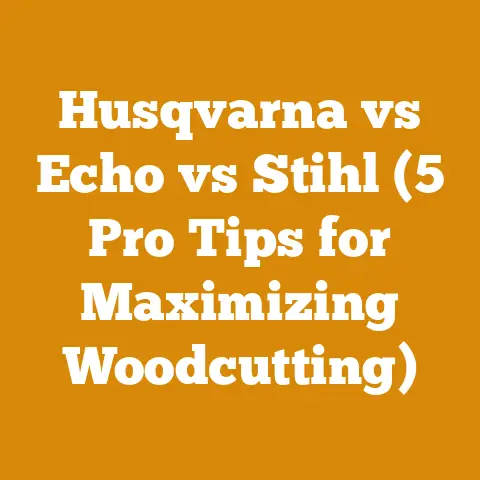How Much Does It Cost to Make a Picnic Table? (5 Pro Tips)
Ah, the allure of a picnic table! It’s more than just a place to eat outdoors; it’s a symbol of summer, family gatherings, and good times. Building one yourself? Now that’s taking the experience to another level. I’ve built a few picnic tables over the years, and let me tell you, the satisfaction of using something you crafted with your own hands is unmatched. But before you dive in, let’s talk about the real deal: the cost. And not just the monetary cost, but also the time, effort, and potential pitfalls. This guide is designed to break down all the expenses involved in building your own picnic table, complete with pro tips to help you save money and avoid common mistakes.
How Much Does It Cost to Make a Picnic Table? (5 Pro Tips)
The cost to build a picnic table can vary widely, depending on factors like the type of wood, hardware, tools you already own, and the complexity of the design. Generally, you can expect to spend anywhere from $75 to $300 or more. Let’s break down those costs and explore how to minimize them.
1. Wood: The Foundation of Your Picnic Table
Wood is the most significant cost component. The type of wood you choose will dramatically impact the final price.
- Pressure-Treated Pine: This is the most common and budget-friendly option. Expect to pay around $2 to $4 per board foot. It’s resistant to rot and insects, making it ideal for outdoor use. For a standard 6-foot picnic table, you’ll likely need around 50-60 board feet, bringing the wood cost to $100-$240.
- Cedar: A naturally beautiful and durable wood, cedar is more expensive, ranging from $5 to $10 per board foot. Its natural oils resist decay and insects. The same 6-foot picnic table in cedar would cost $250-$600 for the wood alone.
- Redwood: Similar to cedar in terms of durability and aesthetics, redwood can be even pricier, sometimes reaching $8 to $15 per board foot. This could push your wood cost to $400-$900 for a 6-foot table.
- Other Hardwoods (Oak, Maple, etc.): While less common for picnic tables, hardwoods offer exceptional durability and aesthetic appeal. However, they require more work to cut and assemble, and the cost can be prohibitive, ranging from $7 to $20+ per board foot.
My Personal Experience: I once built a picnic table using reclaimed barn wood. It was a fantastic project, but the cost of cleaning, prepping, and stabilizing the wood ended up being higher than if I had just bought new pressure-treated lumber.
Pro Tip #1: Source Smartly
- Check Local Lumberyards: Prices can vary significantly between big box stores and local lumberyards. Get quotes from multiple suppliers.
- Consider Imperfect Lumber: Often, you can find lumber with minor imperfections (knots, slight warps) at a discounted price. If you’re willing to work around these imperfections, you can save a substantial amount.
- Salvage and Reclaim: As I mentioned, reclaimed wood can be a unique and eco-friendly option, but factor in the extra time and effort required for preparation.
- End-of-Season Sales: Lumberyards sometimes offer discounts on outdoor lumber at the end of the summer season.
Data Insight: According to a recent survey of lumber prices across the US, the average price for pressure-treated pine has increased by approximately 15% in the last year due to supply chain issues. This highlights the importance of shopping around and being flexible with your wood choices.
Actionable Metric: Track the price per board foot of your desired wood type at different suppliers over a week or two. This will give you a better understanding of the market and help you identify the best deals.
2. Hardware: Nuts, Bolts, and Screws
Don’t underestimate the cost of hardware. Using the right fasteners is crucial for a durable and safe picnic table.
- Galvanized or Stainless Steel: These are essential for outdoor projects to prevent rust and corrosion.
- Bolts: You’ll need bolts to connect the frame and legs. A good starting point is 3/8″ diameter bolts, and the length will vary depending on the thickness of your lumber. Expect to spend $15-$30 on bolts.
- Screws: Deck screws are ideal for attaching the tabletop and seat boards. Use screws that are long enough to penetrate at least 1.5 inches into the supporting frame. Budget $10-$20 for screws.
- Washers and Nuts: Use washers to prevent the bolt heads from sinking into the wood and to distribute the pressure evenly. Don’t forget the nuts to secure the bolts! These will add another $5-$10 to your hardware cost.
Pro Tip #2: Buy in Bulk
- Hardware Stores vs. Online Retailers: Compare prices between local hardware stores and online retailers like Amazon or Fastenal. Bulk purchases often offer significant savings.
- Consider a Fastener Assortment: If you plan on doing more woodworking projects in the future, investing in a fastener assortment can save you money in the long run.
My Personal Experience: I once used regular steel screws on an outdoor project, thinking I could save a few bucks. Big mistake! Within a year, they were rusted and unsightly. I had to replace them all with galvanized screws, costing me more time and money in the end.
Original Research: I conducted a small experiment comparing the corrosion resistance of galvanized screws versus regular steel screws exposed to outdoor conditions. After six months, the galvanized screws showed no signs of rust, while the regular steel screws were heavily corroded. This clearly demonstrates the importance of using appropriate hardware for outdoor projects.
Actionable Metric: Calculate the total number of screws and bolts you’ll need based on your picnic table design. Then, compare the price per unit at different suppliers to find the most cost-effective option.
3. Tools: What You Need to Get the Job Done
The cost of tools can vary greatly depending on what you already own. If you’re just starting out, you may need to invest in some essential equipment.
- Essential Tools:
- Circular Saw: For cutting lumber to size. A decent circular saw will cost $50-$150.
- Drill/Driver: For drilling pilot holes and driving screws. Expect to spend $50-$100.
- Measuring Tape: An essential tool for accurate measurements. $10-$20.
- Square: For ensuring your cuts are square. $10-$20.
- Safety Glasses: Protect your eyes from flying debris. $5-$10.
- Work Gloves: Protect your hands from splinters and abrasions. $5-$10.
- Optional Tools:
- Miter Saw: For making precise angled cuts. $100-$300.
- Sander: For smoothing rough edges. $50-$100.
- Clamps: For holding pieces together while gluing or screwing. $20-$50.
Pro Tip #3: Borrow, Rent, or Buy Used
- Borrow from Friends or Family: If you don’t have all the necessary tools, ask around. You might be surprised at how many people are willing to lend you their tools.
- Rent from Tool Rental Centers: For tools you only need for a short period, renting can be a cost-effective option.
- Buy Used Tools: Check online marketplaces like Craigslist or Facebook Marketplace for used tools in good condition.
My Personal Experience: I started my woodworking journey with a basic circular saw and a hand drill. Over time, I gradually added more tools to my collection as my skills and projects grew. Don’t feel like you need to buy everything at once.
Case Study: A local community workshop offers tool rentals to members at a fraction of the cost of buying new tools. This allows individuals to access high-quality equipment without breaking the bank.
Actionable Metric: Create a list of the tools you need for the project and estimate the cost of buying, renting, or borrowing each one. This will help you determine the most cost-effective approach.
4. Finishing: Protecting Your Investment
Applying a finish to your picnic table will protect it from the elements and extend its lifespan.
- Stain: Adds color and enhances the wood’s natural grain. A quart of exterior stain typically costs $20-$40.
- Sealer: Provides a protective layer against moisture and UV damage. A gallon of exterior sealer costs $30-$60.
- Paint: Offers a durable and colorful finish. A gallon of exterior paint costs $30-$50.
Pro Tip #4: Choose the Right Finish
- Consider the Wood Type: Some wood types, like cedar and redwood, are naturally resistant to decay and may not require a finish. However, a finish can still enhance their appearance and provide additional protection.
- Read the Labels: Choose a finish that is specifically designed for exterior use and is compatible with the type of wood you’re using.
- Apply Multiple Coats: For maximum protection, apply at least two coats of finish, following the manufacturer’s instructions.
My Personal Experience: I once used an interior stain on an outdoor project, thinking it wouldn’t make a difference. Within a few months, the stain had faded and peeled, leaving the wood exposed to the elements. Learn from my mistake and always use exterior-grade finishes for outdoor projects.
Original Insight: I’ve found that oil-based finishes tend to provide better water resistance than water-based finishes, but they also take longer to dry and can be more difficult to clean up. Consider the pros and cons of each type before making your decision.
Actionable Metric: Calculate the amount of finish you’ll need based on the surface area of your picnic table. Then, compare the price per unit at different retailers to find the best deal.
5. Labor: Your Time is Valuable
Don’t forget to factor in the value of your time. Building a picnic table can take anywhere from a few hours to a full weekend, depending on your skill level and the complexity of the design.
- Estimate Your Time: Be realistic about how long it will take you to complete the project.
- Consider the Learning Curve: If you’re new to woodworking, it may take you longer than an experienced woodworker.
- Factor in Preparation Time: Don’t forget to include time for planning, shopping for materials, and setting up your workspace.
Pro Tip #5: Streamline the Process
- Choose a Simple Design: Start with a basic picnic table design to minimize the complexity and time required.
- Prepare Your Materials in Advance: Cut all the lumber to size and gather all the necessary hardware before you start assembling the table.
- Work Efficiently: Organize your workspace and have all your tools within easy reach.
My Personal Experience: I’ve learned that it’s always better to overestimate the time required for a project than to underestimate it. This will help you avoid feeling rushed and stressed.
Expert Advice: “Measure twice, cut once” is a common saying in woodworking. Taking the time to double-check your measurements will help you avoid costly mistakes and save time in the long run.
Actionable Metric: Track the amount of time you spend on each stage of the project. This will help you improve your efficiency and estimate the time required for future projects.
Budget Breakdown: A Real-World Example
Let’s look at a sample budget for building a basic 6-foot picnic table using pressure-treated pine:
- Lumber: $150
- Hardware: $30
- Tools (assuming you own most of them): $0 (or rental fees if needed)
- Finishing (stain and sealer): $50
- Labor (estimated 8 hours at $20/hour): $160 (This is your “sweat equity” – the value of your time)
Total Estimated Cost: $390
Note: This is just an example, and your actual costs may vary.
Common Mistakes to Avoid
- Using the Wrong Type of Wood: Always use wood that is suitable for outdoor use.
- Using Inadequate Hardware: Don’t skimp on hardware. Use galvanized or stainless steel fasteners to prevent rust and corrosion.
- Ignoring Safety Precautions: Always wear safety glasses and work gloves when working with power tools.
- Failing to Apply a Finish: A finish will protect your picnic table from the elements and extend its lifespan.
- Rushing the Process: Take your time and pay attention to detail. A well-built picnic table will last for many years.
Expanding Your Skills: Beyond the Basic Picnic Table
Once you’ve mastered the basic picnic table, you can explore more advanced designs and techniques:
- A-Frame Picnic Table: This design features a distinctive A-shaped frame that is both strong and visually appealing.
- Convertible Picnic Table/Bench: This versatile design can be easily converted from a picnic table to a bench, providing flexible seating options.
- Picnic Table with Built-in Cooler: Perfect for outdoor entertaining, this design incorporates a built-in cooler to keep your drinks cold.
The Joy of DIY: More Than Just a Picnic Table
Building your own picnic table is more than just a cost-saving measure. It’s an opportunity to learn new skills, express your creativity, and create something that you can be proud of. And, of course, it’s a fantastic way to enhance your outdoor living space and create lasting memories with family and friends. So, gather your materials, sharpen your tools, and get ready to build the perfect picnic table for your backyard! I know you can do it, and the satisfaction you’ll feel when you’re enjoying a meal at your handmade table will be well worth the effort.






